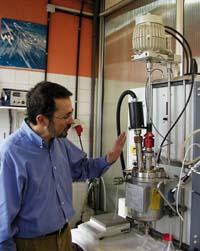José María Asua: "Technology has brought us quality of life"

At present, the polymerization in emulsion is viable by the absence of solvents in the products and by the impossibility of obtaining them in another way. There is no other way to get a polymer ball of nanometer tissue, for example.
Consider a PVC impact absorber. PVC is by itself rigid and therefore fragile, as is the majority of rigid substances. Pieces of nanoscopic rubber are introduced to prevent PVC breakage. These rubber parts are made of emulsion and are coated with a methyl polymethacrylate that is compatible with PVC. This way you get a powder that is mixed with PVC and you have it!
It's easy, but a lot of work has been done to find it.
Basically, polymerization in emulsion is a way to make a polymer dispersed in water. In fact, emulsion polymers are hardly used for the manufacture of parts. Almost the only piece that is manufactured by emulsion is pneumatic. Otherwise, in general, things are done like: post-it adhesive notes, book covers... In general, the larger the paper size, what is called couché, the more polymer it contains. If the paper was not covered with polymers, when writing the pen ink would be extended.
It is also used for the treatment of leather, to make it so soft you need a polymer. Today there are many tissues that are treated with polymers, such as those that scare away from rain water and dirt, are tissues covered with emulsion polymers.

Well, yes and no. If we speak of tons, it is true that approximately 90% of the production is a few polymers. The sum of polyethylene, polypropylene, styrene, PVC, nylon, PET and polyurethane is approximately 80-90%. But each of these polymers is a family. Therefore, instead of nylon, we should say nylon, instead of polyurethane, polyurethane, etc.
In addition, many copolymers are used in the specialties. The copolymers are polymers made with different monomers. That is, polyethylene is a polymer that only has ethylene monomer, but with two different monomers a copolymer is formed. For example, with styrene and butile varnish, a polymer very used in the paints is formed. And adding other monomers, new features are obtained.
All this makes polymer families very large. A polymerization factory in emulsion not very large usually has a catalogue of hundreds of products. The combinations are made using different monomers and using different proportions. Therefore, think of the opportunity.
All products are adapted to the customer. But when talking about the option you have to differentiate between producer and buyer. And it is that the producer tries to create a catalogue of products that serves almost anything. Thus, when the buyer comes with a certain need, you will find in the catalogue the product that satisfies it. The revolution with clothes about 30 years ago is similar to that.
In the past, they harvest our clothes to measure. But one day we went to the shop and found the clothes made, with different measures, to choose the most suitable. In polymer companies they try to do something similar. That is, they manufacture products to measure for a specific application. However, if you are one of these great customers, you can ask them what you want, but normally the customer has to adapt to the products that are in the catalogue.
As has already been indicated, this catalogue product is made to measure for a specific application. They know perfectly the composition of this polymer, the distribution of molecular weights, the architecture of the chains and everything else.

Because the truth is that in literature the term recipe is used very much. I like the word formulation more; I leave the recipe for serious things, for the kitchen and...
Apart from the jokes, I prefer the word formulation, but carefully I do not mean that only the components are expressed, but also the components and the way to carry out the reaction appear. That is, the temperature profile, how to add each of the components of the formulation, how to make the mixture, etc., is the path that makes a polymer and not another.
It is very difficult. And I think it's a message to send to society. We have a kind of bucolism about life 'naturally'. But technology has given us quality of life.
We tend to look at negative aspects of technology. But without those advances, life would be very hard. Imagine what was food without phytosanitary products, for example. It has not been a century since then.
It is not wrong to look at what is missing, that is, we have to improve the environment, of course. But we cannot renounce technology, it is not possible.
Well, on the one hand, we will have to pay the most expensive polymers. On the other hand, it should be noted that the fraction of carbon and hydrogen compounds used in polymer production is low (polymers are basically carbon and hydrogen). In addition to oil, coal can also be used to produce polymers, since carbon can be extracted synthesis gas and thereby develop all petrochemicals.

In reality no oil is needed. But it's cheap, and that's why it replaced coal. And there are other options, the biomass itself at the end. It contains carbon and hydrogen and is very abundant.
No. And in addition, there are other options. From natural gas, for example, chemistry is simpler than from oil. In fact, almost all the petrochemical part of ethylene (at the base are ethylene, benzene and xylienes), from which the rest are obtained.
I think the real problem will be energy: heating, light, industry resources, transportation... That is the real problem. Moreover, little is used as raw material. And in the case of polymers it is solved. Of course, the problem will be economic.
Buletina
Bidali zure helbide elektronikoa eta jaso asteroko buletina zure sarrera-ontzian











